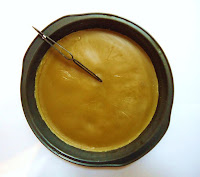In my Wednesday series exploring perfume materials I have to start somewhere, so
will begin by considering a new essential oil that I recently acquired but have
yet to use in a formula.
Palo santo, aka Bursera graveolens, is a deciduous tree that grows throughout
Central America and parts of South America. It is in the same family as
frankincense and myrrh, so the wood is resinous and aromatic. The trees are
attractive, with chunky trunks and branches, compound leaves with broad
leaflets, small yellow-white flowers, and small round fruits.
A long time ago I had bought a small bottle of palo santo
essential oil, but didn’t like the smell, so never used it. However, late last
year I bought some palo santo wood chips for burning and was immediately wowed
by the fresh, clean, green smell of the wood, both in its raw state and when
burning. I suddenly understood why palo santo wood was used by the Incas in
purifying rituals and is still used for similar purposes in aromatherapy. It really does smell exceptionally clean and uplifting. I decided to give palo santo essential oil
another try.
I bought a good-sized bottle of palo santo oil from a
reputable supplier, and after smelling two different versions have learned that there seems to be a lot of variation in
palo santo oil from different sources. The new oil has many of same the fresh,
green notes that the wood has, but I do detect a small amount of “off”-notes
similar to those in the original bottle that I got. I would characterize these contaminating notes
as “greasy moth balls and pea soup”.
This seems to be something that is generated when the wood is distilled,
not something that is in the raw wood itself.
I really want to use palo santo in a fragrance, but will
need to find a workaround to mask the “off”-notes and enhance its unique suite
of clean, green notes.
I will be traveling this weekend through next Thursday, so may miss next Wednesday's materials post. If you would like to be entered in a drawing for a sample of palo santo oil diluted to 25% so that you can apply it as a perfume and experience the material by itself, leave a comment relevant to this post. Unfortunately, due to exorbitant international postage costs for small packages, this is a US and Canada only drawing. There will be a few international giveaways in future, so keep watching for them.
[Images are from Wikimedia or a retailer's website]





















